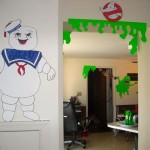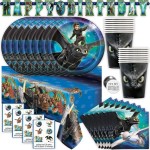Wall Decoration For Kids Room: Creating an Inspiring and Functional Space
A child's room is more than just a place to sleep; it's a sanctuary for imagination, a haven for play, and often the epicenter of their developing world. The aesthetic of this space plays a critical role in fostering creativity, promoting a sense of security, and influencing their overall well-being. Wall decoration is a significant aspect of creating this environment. Thoughtful and age-appropriate wall décor can stimulate a child's curiosity, encourage learning, and reflect their unique personality.
This article explores various aspects of wall decoration for kids' rooms, focusing on creating a functional and inspiring space. Considerations will be given to different themes, age groups, decorative materials, and safety precautions, while ensuring the space is both aesthetically appealing and conducive to a child's growth and development.
Theme Selection and Age Appropriateness
Selecting a theme is often the first step in decorating a child's room. The chosen theme should resonate with the child's interests and developmental stage. For younger children, common themes include animals, nature, transportation, and simple geometric patterns. These themes are generally visually stimulating and help introduce basic concepts.
For example, a rainforest theme could incorporate wall decals of various animals, a painted mural of lush foliage, and perhaps even some textured wall elements to simulate the feel of tree bark. This theme provides an opportunity to introduce children to different animal species, plant life, and ecological concepts. Similarly, a transportation theme might involve wallpaper featuring cars, trains, and airplanes, paired with road-themed rugs and toy storage solutions. This can encourage imaginative play and a basic understanding of different forms of transportation.
As children grow older, their interests become more defined and complex. Themes for older children might revolve around hobbies, sports, favorite characters, or abstract concepts. Murals depicting galaxies, cityscapes, or underwater scenes can be particularly engaging for this age group. Consider involving the child in the selection process to ensure the theme reflects their personal preferences and fosters a sense of ownership over their space.
Furthermore, the level of sophistication in the decoration should increase with the child's age. While simple cartoon characters might be suitable for toddlers, older children may prefer more realistic depictions or abstract artwork related to their chosen theme. The color palette should also be carefully considered. Bright, primary colors are often used in younger children's rooms, while older children may prefer more muted or sophisticated color schemes.
It is crucial to ensure the chosen theme remains appropriate as the child grows. Themes and décor should be adaptable and easily updated to reflect evolving interests and developmental milestones. For example, wall decals are a relatively inexpensive and easily removable option for updating a room's theme as the child matures. Avoiding overly childish themes or characters that might become embarrassing as the child enters adolescence is also important.
Decorative Materials and Techniques
The choice of decorative materials and techniques significantly impacts the overall look and feel of a child's room. A variety of options are available, each with its own set of advantages and disadvantages. Paint, wallpaper, wall decals, murals, and fabric wall hangings are among the most popular choices.
Paint is a versatile and cost-effective option for wall decoration. It allows for a wide range of colors and finishes, and can be easily reapplied or changed as the child's tastes evolve. Choosing low-VOC (Volatile Organic Compound) paints is crucial to ensure good indoor air quality, especially in a child's room. Different paint techniques, such as stenciling, sponging, and color blocking, can also add visual interest to the walls.
Wallpaper offers a broader range of patterns and textures compared to paint. It can be used to create a specific ambiance or to add a touch of sophistication to the room. Modern wallpaper options are often peel-and-stick, making them easier to apply and remove than traditional wallpaper. However, wallpaper can be more expensive than paint and may require professional installation for complex patterns.
Wall decals are a popular choice for adding characters, patterns, or quotes to a child's room. They are relatively inexpensive, easy to apply, and easily removable, making them a good option for temporary decorations or for updating the room's theme. Decals come in a variety of sizes, shapes, and colors, allowing for significant customization. However, some decals may not adhere well to textured walls, and may peel or fade over time.
Murals offer a more personalized and impactful form of wall decoration. They can be hand-painted or printed on wallpaper and can depict a wide range of scenes, from landscapes to abstract designs. Murals can be a significant investment, but they can transform a room into a unique and captivating space. When commissioning a mural, it is important to work with a reputable artist who understands the principles of child development and can create a design that is both visually appealing and age-appropriate.
Fabric wall hangings can add warmth and texture to a child's room. Quilts, tapestries, and banners can be hung on the walls to create a cozy and inviting atmosphere. Fabric hangings can also be used to showcase the child's artwork or to display collections of toys or memorabilia. However, fabric hangings can accumulate dust and may require regular cleaning.
Functionality and Safety Considerations
Beyond aesthetics, functionality and safety are paramount when decorating a child's room. The wall décor should contribute to the overall functionality of the space and should not pose any safety hazards. Sharp edges, loose parts, and toxic materials should be avoided.
Storage solutions can be integrated into the wall décor to maximize space and keep the room organized. Shelves, cubbies, and wall-mounted organizers can be used to store books, toys, and other belongings. These storage solutions should be securely attached to the wall to prevent them from tipping over. The height of the storage units should be appropriate for the child's age and reach, allowing them to access their belongings easily.
Artwork created by the child can be prominently displayed on the walls, fostering a sense of pride and accomplishment. Frames, clipboards, and gallery walls can be used to showcase the child's creations. Rotating the artwork regularly keeps the display fresh and engaging. Ensure any frames used are lightweight and shatterproof, preventing injuries if they were to fall.
Lighting plays a critical role in creating a functional and comfortable space. Wall sconces, nightlights, and string lights can be used to provide adequate illumination for different activities. Nightlights can provide a sense of security and comfort for young children, while sconces can be used to create a reading nook. Ensure all lighting fixtures are securely mounted and that electrical cords are out of reach of children.
Safety is a primary concern when decorating a child's room. Avoid using heavy or breakable items that could fall and cause injury. Securely attach all wall decorations to the wall, using appropriate hardware and anchors. Avoid using nails or tacks that could be easily dislodged. Use non-toxic and child-safe materials whenever possible. Check all decorations regularly for signs of wear and tear and replace them as needed.
In terms of paint, use low-VOC or no-VOC paints to minimize the release of harmful chemicals into the air. These paints are safer for children and the environment. When using wallpaper or wall decals, choose materials that are easy to clean and resistant to mold and mildew.
Consider the placement of furniture and decorations to avoid creating hazards. Avoid placing furniture near windows or outlets, and use cord covers to protect children from electrical shock. Place bookshelves and other tall furniture against the wall and secure them with anti-tip brackets.
Finally, consider the acoustics of the room. Hard surfaces can create echoes and make the room feel noisy. Using soft materials, such as rugs, curtains, and fabric wall hangings, can help to absorb sound and create a more peaceful environment.
By carefully considering the theme, materials, functionality, and safety aspects of wall decoration, it is possible to create a child's room that is both aesthetically pleasing and conducive to their growth and development. A well-decorated room can stimulate their imagination, encourage learning, and provide them with a sense of security and belonging.

Kids Room Wall Ideas For Creative Child Development Blog Square Signs


10 Kids Room Wall Decor Ideas That Pas Won T

Spectacular Wall Designs For Children S Rooms

Pin On Dining Room Wall Art

15 Inspiring Wall Décor Ideas For A Kids Room Articles About Beautiful Decor

Kids Room Wall Ideas For Creative Child Development Blog Square Signs

Kids Room Wall Decor

15 Inspiring Wall Décor Ideas For A Kids Room Articles About Beautiful Decor

26 Best Kid Room Decor Ideas And Designs For 2025







